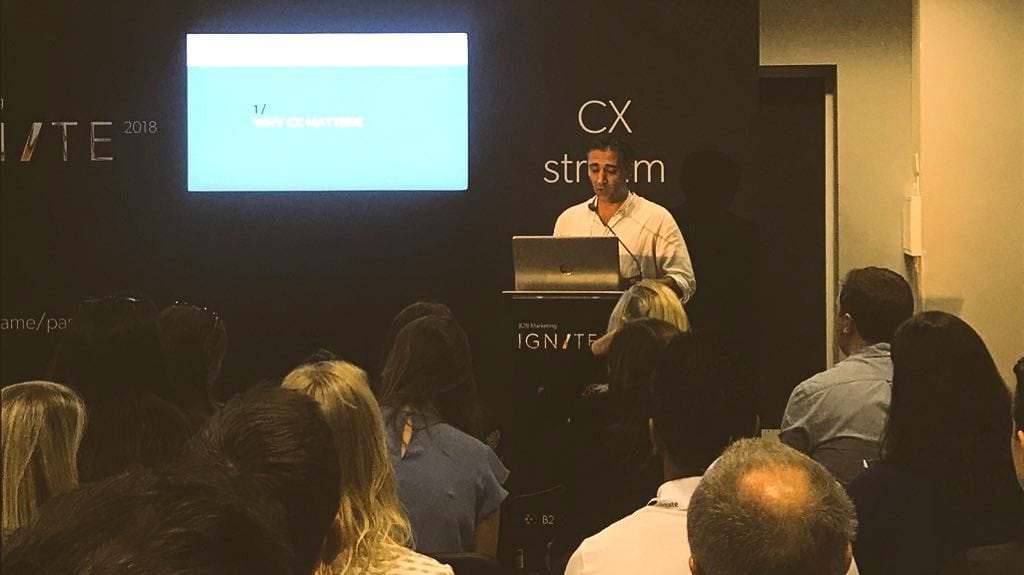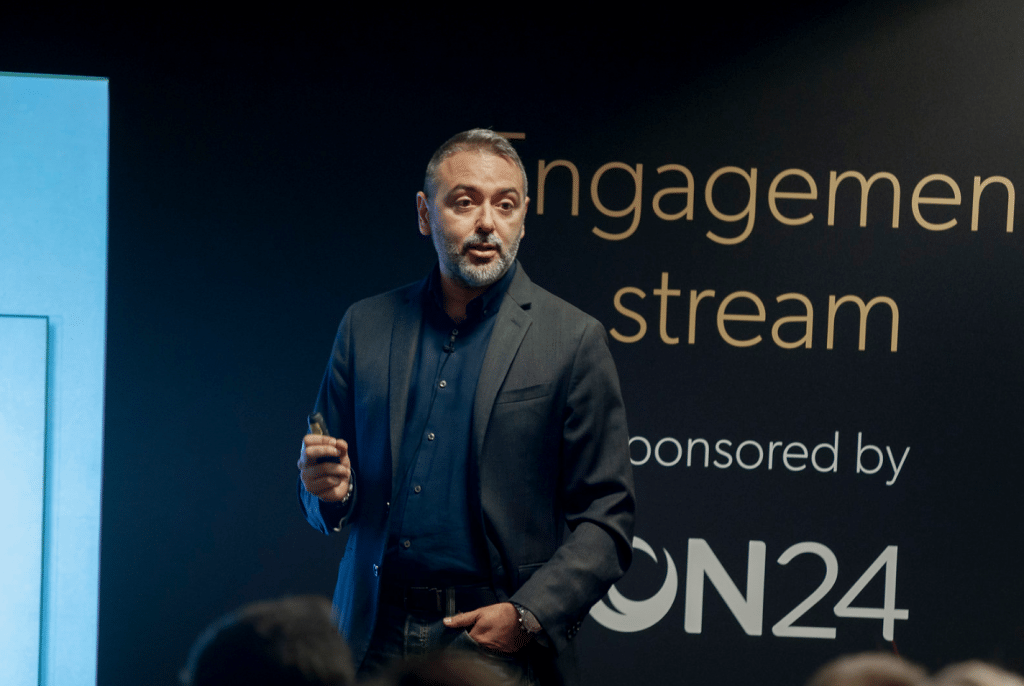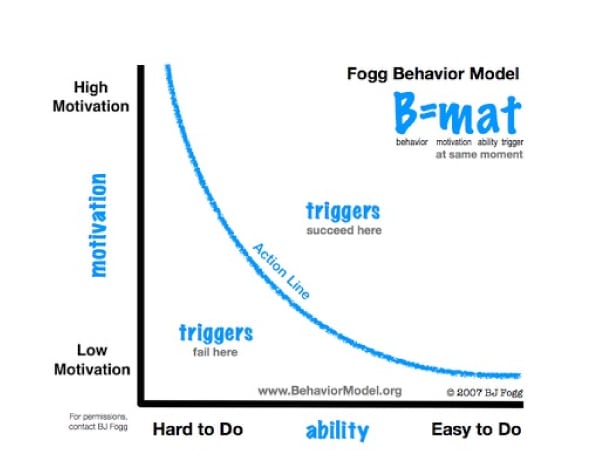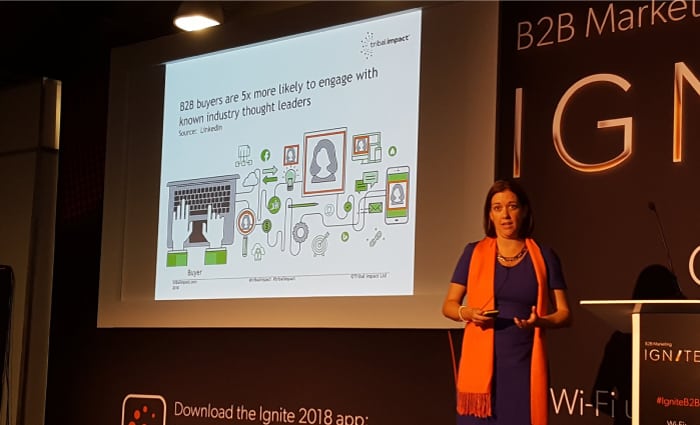B2B Ignite 2018 took place on 10th July at the Business Design Centre in Islington. This year was the biggest yet with 1200 people in attendance from Marketing Managers through to C-Suite and B2B leaders. There were 66 seminar sessions across 8 topic streams from the leading names and influencers in the B2B space providing new, innovative and inspiring ideas, as well as the exhibition space featuring leading edge B2B suppliers and vendor brands plus the Tech Playground. Here’s my key takeaways from the 7 talks I attended this year:
Rory Sutherland – Think You Understand B2B Buyers? Think Again …
Rory Sutherland is the Vice Chairman of Ogilvy Group UK. He is often being described as the ‘father’ of behaviour science in marketing, coming across as a fiercely intelligent and highly amusing speaker and commentator. He has 30 years experience at Ogilvy as a copywriter, with an equal split of experience in B2B and B2C marketing. He started by highlighting that in B2C consumers don’t act as rational consumers are supposed to act, and in B2B business people don’t act as rational business people are supposed to act. Marketing is based on human insight into what people really want, as opposed to what they say they want. The incorrect assumption that buyers behave in an economists’ definition of rationality is particularly more prevalent among non-marketing colleagues in a B2B environment. One will never be blamed for this assumption. As a marketer you need to have an overriding fear of the obvious, by perusing the logical route you will end up in the same place as your competitors which is an overcrowded space. According to a book on evolutionary psychology by Dan Sperber and Hugo Mercier called The Enigma of Reason the human brain evolved a sense of reason not to make decisions but to defend the decisions that you have already made and to argue our case.
Marketing is the science of knowing what economists are wrong about. Economics assumes perfect knowledge and perfect trust. We’re not primed to make decisions in these perfect conditions, we make decisions instinctively based on imperfect information and then rationalise our decisions. 5 things that humans care about massively but which economists don’t understand at all are:
- Status – Sense of achievement, even bigger in B2B marketing than in B2C.
- Certainty – We make decisions that are least likely to be terrible. Nobody ever got fired for hiring IBM.
- Autonomy – We like optionality, we don’t like being tied in.
- Relatedness – We like dealing with the same person, we prefer connectedness, reciprocation and social capital.
- Fairness – We care about what the other guy gets and want to be sure we are getting the best deal.
When creating something first ask yourself the question, what does everyone assume we might be wrong about? Creativity is very much a subtractive process, removing that assumption. If there was a logical answer we would have already found it. If you want to make a drink that competes with coke come up with a drink that tastes nicer than coke, is cheaper than coke and comes in a really big can. No one will get thrown out of the room for making that suggestion. What was the most successful attempt to compete with coke in 150 years? Red Bull, comes in a tiny can, costs a fortune and tastes disgusting. The way to make progress is as much “Innervation” – perception based innovation to literally “synthesize value out of nothing” – than innovation.
You can watch Rory’s full talk here.
René Power – Smile for the camera – Using video to deliver kickass B2B customer service!
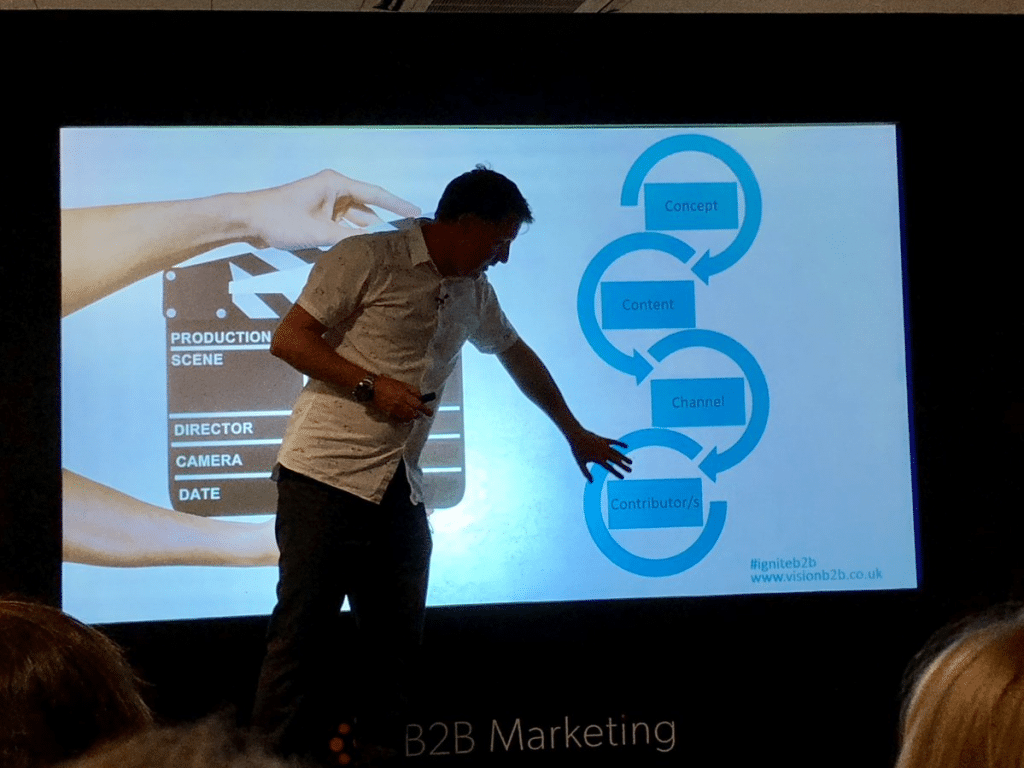
René Power is the founder of Vision B2B Marketing & Training and his talk focused on how video and webinars offer a powerful way to build a business and engage customers. He discussed how video is the most preferred content tactic and can play a powerful role in B2B with the various use cases including:
- Training – for both staff and customers
- Demonstrate / promote your product
- Attract new customers
- Increase conversion rates
He spoke of the AIDA marketing model (Awareness, Interest, Desire and Attraction) to describe the stages that occur from the time when a consumer first becomes aware of a product or brand through to when the consumer trials a product or makes a purchase decision. By using video you can help your prospects through the funnel by letting them “meet” you, like you, know and start to trust the person behind the brand. Some of the ways video can help you do this are:
- Broadcasting – one to many videos, profiling your product. E.g. Webinars
- Messaging – One-minute long videos speaking directly to your prospects or customers
- Video Diary – A day in the life
- Quick tips, how to videos
- Live Q&A interviews
- Video follow up
These are some of the new creative ways you can use video to spark interest, acquire, serve and nurture prospects and customers
René also introduced us to his model for video and content strategy and production. The 4 C’s Concept > Content > Channel > Contributor.
Jason Talbot – CXy Marketing – The key competitive differentiator in the digital age
Jason Talbot is the Managing Director & Partner at The Crocodile – the official live streaming partner of B2B Ignite. His talk focused on how high performing B2B marketing departments are leading the customer experience charge. They are challenging old norms and have already broadened their scope beyond the funnel and back.
Jason started by talking about why CX matters and quoting Peter Drunker who said “Marketing is not a function, it is the whole business seen from the customer’s point of view.” The customer has become an abstract notion as marketers rarely meet them. Get to know your customer because you can’t divorce the employee and the customer experience, they are intrinsically linked and you can’t achieve one without the other.
30% of Fortune 500 companies have made the shift to CX strategies. Customers conduct a referendum on your brand everyday. Failures in communications or the customer journey can easily cause a customer to judge your brand in a negative way. Customers are more sceptical and trust is at an all-time low. The strategic fundamental principles of good CX are that it needs to be seamless, orchestrated, contextual, convenient and responsive.
CX is as relevant to B2B as it is it to B2C. All experience is driven by a person’s exposure to absolutely everything, people don’t switch from human mode to B2B mode.
We are a long way from mass adoption of CX strategies, and there is clearly a need for more buy-in from senior management. Marketers need to look at the business through the eyes of their customers and take control of disciplines such as:
- Customer relationship marketing
- Customer journey mapping
- Organisational change and skills development
CRM is not a platform, it’s a strategy.
Tim Williams – How to Integrate Influencer Marketing into your Marketing Mix – Business Case, Engagement Models and Measuring Success
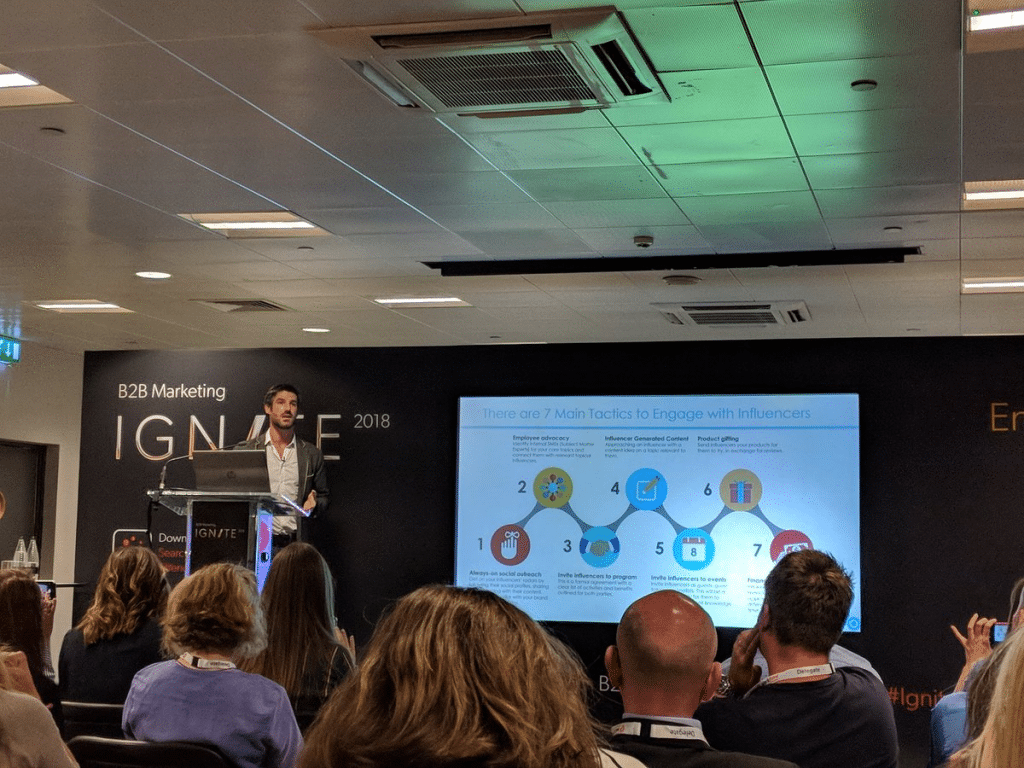
Tim Williams is the CEO of Onalytica. To much amusement Tim started by making the distinction that he was from Onalytica, not to confused with Cambridge Analytica, and that we are completely GDPR compliant. He then initiated a fun interactive quiz about influencer marketing, where the audience logged in on their phones to take part. To incentivize participants a prize of a £50 voucher was up for grabs. The questions included facts such as:
- “According to Buzzsumo, how much has social sharing of online articles decreased by since 2015?” – Answer 50%
- “How much has the search frequency of ‘influencer marketing’ increased by since 2015?” – Answer 1000%
Following the frenzy of the quiz, Tim talked about how the market is changing; brand loyalty, advertising effectiveness, trust and attention span are all down. Whereas content creation, consumer control, brand choice and media channels are all on the rise. For this reason, influencer marketing has grown massively in popularity over the last few years. 84% of B2B buyers start the purchase process with a referral and by engaging with the top 1% of influencers you can influence 80% of the market. However, many are still unsure as to how they can effectively connect with influencers, drive engagement, measure impact, or crucially secure internal buy-in.
Tim went on to address the topic of Fantasy Influences. By this he means the Kim Kardahians, TV personalities or Big YouTubers of the world. In reality much of the real influencers come from a wide variety of sources and backgrounds. Such as Health Care consultants, FinTech keynote speakers, Politicians or Developers for example. These individual influencers will resonate with different audiences.
He then provided a clear and logical framework for how to run your influencer marketing programs, including the 6 stages to Influencer Relationship Management:
- Discover – identify your influencer community, select engagement targets
- Map – Understand your community and the market flow of influence
- Listen – Track influencer posts and surface outreach and content sharing opportunities
- Engage – Reach out to influencers, and move them through the pipeline stages.
- Measure – Influencer engagement, brands awareness, brand share of voice, brand perception and community insights
- Scale – Scale and structure your program, build relationships with more influencers
When ranking your influencers, it’s better to look at their topical relevance, engagement and authority rather than their reach. Other factors to consider are what type of influencer you should engage with? Everyday influencers, brand advocates, micro-influencers? What about their personas, are they social amplifiers, or content creators for example?
There are 7 main tactics to engage with influencers:
- Always on social outreach – share and engage with their content, make them familiar with your brand and build relationships
- Employee advocacy – use internal subject matter experts (SMEs) and connect them with relevant influencers
- Invite influencers to a program – Create a formal agreement with a clear list of activities and benefits for both parties
- Influencer generated content – Approaching an influencer with a content idea on a topic relevant to them
- Invite influencers to events – Network, increase yours and their exposure and knowledge
- Product gifting – Send influencers your products for them to try / review
- Financial compensation – In some cases financial compensation may be appropriate, but the key is to pay for their time, not their opinion.
When working with influencers it’s important to consider what value you can offer them and their audience. For example early access to content, products, industry research etc. Access to a new audience, backlinks to their website, networking opportunities, content generation (e.g. interviews, video, etc.). The partnership needs to be of equal value to the brand and the influencer.
To effectively measure the success of an influencer programme Tim showed us a framework for measuring the inputs, outputs and outcomes as influencers move through the pipeline.
Finally, Tim finished off by showing us various Case studies of how Onalytica have helped brands such as Thompson Reuters, VMWare, VisualIQ and Sage with their influencer marketing strategies.
You can see the slides from the presentation here.
Jason Miller – How LinkedIn Uses LinkedIn for Marketing
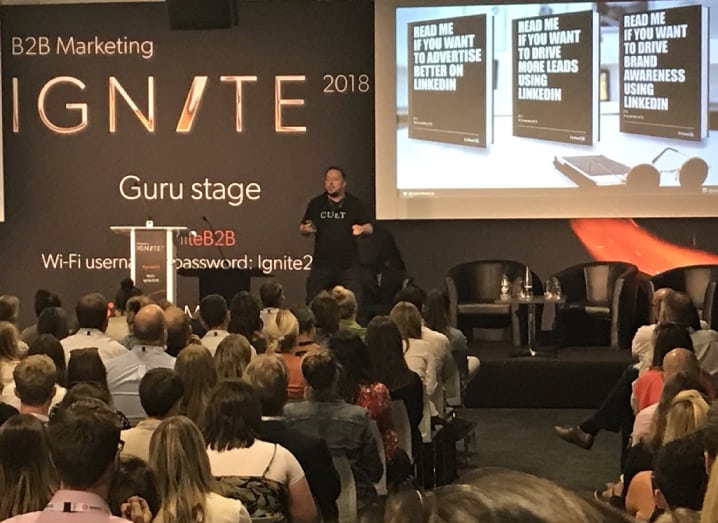
Jason leads content and social media marketing for LinkedIn Marketing Solutions, helping marketers understand how to use LinkedIn to achieve their marketing goals and deliver real ROI. Previously, he was the senior manager of social media strategy at Marketo. Jason was set with the objective of raising brand awareness and driving demand on the world’s largest professional social network. In discussing how LinkedIn uses its own platform to market to customers and prospects across the entire funnel, he started by stating that what they were doing a few years ago doesn’t work anymore, there are no quick wins, no original content, it’s just how you put your own spin on it. The big winners are sites that have built a strong reputation for original authoritative content.
For ‘Big Rock‘ pieces of content LinkedIn get about 100 or so different creatives for the ads and the blog headers, then test everything to see what works. This time he wanted to experiment with taking all the creativity out of the content and giving people pure relevance. So he created content with a simple black cover and white text saying “Read Me if you want to … ” and then stating exactly what the content will help you to do. Inside the white papers included designs by Brian Cannon famous for his work in the 90’s creating album covers for Oasis.
Jason goes on to say they tried introducing “pre-ordering” to the mix, similar to how you would pre-order an album from iTunes. “This is coming in 2 weeks, register here if you want to be first to know”. They tested promoting the content with short form and longer form videos and on-the-fly videos. They tried using more in-depth case studies, and warmed up the audience with sponsored content, before hitting them with an InMail. Making sure to squeezeevery ounce of value out of the Big Rock pieces of content. Ads were localised – translated into the local language. They tried segmenting the audience by the relevant piece of content, e.g. sending a message just to the marketers “Hey Marketers, check this out”, etc. but what they discovered is that everyone just wanted to download everything all at once.
Jason finished by talking about the importance of Brand Awareness vs Lead Generation. Previously they valued lead gen more, but that now it was probably more of a 50/50 between the two.
He also gave a good tip about installing the marketing solution Insight Tag on your website, which allows you to define specific audiences to track, and provides you with audience insights that you can apply to your marketing.
Giuseppe Caltabiano – The psychology behind content: How to trigger your users’ behaviour
Giuseppe Caltabiano is the Head of Content Strategy at Contently. His session explored how to apply principles of psychology to content hub design and content marketing and maximise visitor attention. Using psychology you can trigger an action, this is not about tricking someone into doing something but rather about persuasion. Methods of persuasion depend on the type of user. The hybrid marketer understands the significance of the principles of psychology and how it can influence the buyer’s behaviour. It is possible to design your content with psychological nudges that can accelerate the buyer journey.
There are two different routes to persuasion that a user will take:
Central route to persuasion occurs when a person is persuaded by the content of the message. The details and specifics in the content such as pricing. Central route means your audience cares more about the message. They’ll pay more attention and scrutinize the quality and strength of the argument. Any attitudes formed or reinforced this way are thought to be more resistant to counter-arguments.
Peripheral route to persuasion occurs when a person is persuaded by something other than the message’s content. This happens on a more superficial level. Your audience will pay less attention to the message itself while being influenced by secondary factors, such as source credibility, visual appeal, presentation, and enticements like food, sex, and humour. Attitudes formed or reinforced this way are thought to be less enduring, subject to change through counter-arguments, and in need of continual reinforcement.
Researchers have found two main factors influencing a shift to the central route: motivation and ability.
Motivation is often influenced by relevance. A user who feels directly impacted by a topic is more likely to process a message through the central route.
Ability is a straightforward concept. For central route processing to occur, your message must align with your audience’s thinking capabilities. If people lack the mental ability to process your message, they will not be able to critically evaluate it, and are guaranteed to process it through the peripheral route.
In other words: If you want people to pay attention to your content, make it relevant and easy to understand. The Fogg Behavior Model can help you connect motivation and ability.
Fogg’s model explains that three elements must come together at the same time for a behaviour to occur: motivation, ability, and a trigger. When a behaviour does not occur, at least one of those three elements is missing. Ability and motivation have a trade-off relationship when it comes to performing behaviours. We must design our content to increase motivation and ability to the point where a trigger (Call to Action) will be successful.
Central routing may be the best way if you want people to understand your content, but peripheral route will be the best way if you want to give people a short-cut to persuasion. This can be achieved by giving away something for free. Instigating feelings of scarcity. Scarcity can be very powerful. By using limited time offers or showing consumers what their friends are purchasing, you can create a sense of urgency to buy. Another powerful technique is to offer the users social proof – for example telling them “by clicking here you will be joining 600K valued members of this community”. Reviews and testimonials also provide powerful social proof that can help trigger an action.
Sarah Goodall -Authentic Marketing: It’s Time To Activate Your Employee Voice
Sarah Goodall is the Founder of Tribal Impact, a Marketing and Advertising company that helps brands through training, tools and content to transform employee, partner and customer communities into social advocates for the business.
Sarah made the point that we live in a transparent world where trusted networks are driving more influence than finely crafted marketing campaigns. She illustrated this with an example of buying a car seat for her daughter where she found herself trusting the reviews of 257 people she had never met with her daughter’s safety. By the time she reached the store she was well informed and ready to purchase.
Buyers are digital first, and decisions are influenced at the top of the funnel. Buyers have the power to self-educate and you won’t hear from them until you’ve been shortlisted. Marketers are moving further down the funnel, educating the buyer. People trust people, not logos and your employees are well positioned to reach new audiences, deepen customer relationships, strengthen brand voice and create expert content. B2B buyers are 5x more likely to engage with known industry thought leaders – your experts!
Authentic marketing at its most basic is putting your employees in front of the logo as your employees are key to unlocking these authentic buyer journey top of funnel conversations. This is especially true in the B2B market where buyers are five times more likely to engage with influencers – and those influencers are in your company.
Despite the fact that only 3% of employees share content, they generate 30% of all content engagement for a typical business. By putting your employees in front of the logo you are creating an opportunity for them to showcase their expertise and build credibility. So, how do you nurture employee advocacy and more importantly, how do you measure the impact within your business? You need to understand their motivations and limitations. For example an account manager will want to know they can increased their pipeline, whereas a company leader will want to drive revenue growth. Identify your social heroes and your social zeros and align training needs accordingly.
Pitfalls to avoid:
- Lack of clear objectives
- No executive sponsorship
- Siloed approach to employee activation
Use data to build your business. Measure the SSI scores on LinkedIn. There is a direct correlation between high LinkedIn activity (shares, clicks, posts, engagement) and the size of your pipeline.
If you’re interested in speaking with one of our consultants to outline the results that you can achieve in your influencer program, get in touch by clicking the button below.


